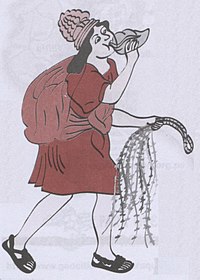Chaski
A chaski or chasqui ( Quechua : messenger) was a well trained runner. The Chaski delivered messages across the entire Inca Empire , thus serving the Inca rulers .
They used the Inca paths and Inca bridges for this purpose , which, in addition to troop movements and the transport of goods, also served for the rapid transmission of messages. On the coast they served the area between Nazca and Tumbes . The Chaski carried a pututu ( snail horn ), a quipu , on which they stored information, and a qipi (backpack, bag) with them. They chewed coca leaves as a stimulant .
Each Chaski ran a section between two meeting points where other runners were waiting to relieve them. These meeting points at intervals of between 15 and 25 kilometers and in the Atacama Desert of over 42 kilometers were called tambos , in which the Chaski could rest and eat. Through this replacement process, the Chaski were able to deliver messages over thousands of kilometers within a few days. An example of such a message delivery was a run from Cuzco to Quito (about 2,800 kilometers) in less than a week. They also supplied the Inca rulers with fresh fish from the coast in the capital of Cuzco, 3400 meters high in the Andes and 600 kilometers from the coast. Their extensive runs led them through areas of today's states of Colombia , Ecuador , Peru , Bolivia , Argentina and Chile . The Chaski had a pronounced defensive potential, as they had mastered various fighting techniques.
Other meanings
The legendary reputation of the Chaski goes back to today's culture in the Andean countries. Various organizations, music groups and media bear this name. A cartoon of a Chaski was used as the mascot for the 2004 Copa América , hosted by Peru that year. The first Peruvian amateur radio satellite was named Chasqui-1 .
Web links
Individual evidence
- ^ John Hyslop, Mario Rivera: An Expedition on the Inca Road in the Atacama Desert. In: Archeology , Vol. 37 (1984), Issue 6 (November / December), pp. 33-39, here p. 39.

